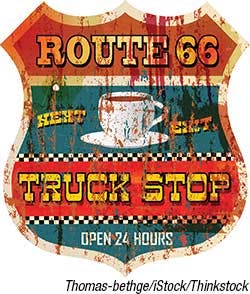The evolution of truck stops
The modern-day travel plaza with a movie theater, food court, and gym has its roots in the old West. It can be traced back to the famed Pony Express mail delivery and the stagecoach lines that brought passengers, freight, and mail west.
For as long as Americans have been crossing the country, they’ve needed places to rest, refuel, and get something to eat. For Pony Express riders, who in 1860 began carrying saddlebags of mail along a route from St Joseph MO to Sacramento CA, the way stations were little more than places to swap horses along the 2,000-mile trail.
Because they could carry up to nine passengers, stagecoaches, which reached their peak in the 1860s, required something a little more hospitable. Stagecoach stations were about 12 miles apart, and the nicer ones offered a meal and overnight lodging.
Soon, horses gave way to railroads, then the internal combustion engine. As the cars grew more powerful and drivers ranged farther from home, there grew a need for places for them to eat and refuel.
Truck stops began evolving into travel plazas in the 1980s as operators pursued four-wheelers and RVs. Corporate ownership did their best to scrub the sites of the seamy images truck stops once had and began adding features such as gift shops, movie theaters, and more.
Though the corporatization of travel plazas has resulted in a certain sanitized sameness, there are still some truck stops out there that have become destinations purely for their size or kitschy appeal.
Among them: South of the Border, a 67-year-old, Mexican-themed stop in Hamer SC, which features a reptile lagoon, amusement rides, and a sombrero-shaped restaurant; Iowa 80 Truckstop, “The World’s Largest,” which opened in Walcott in 1964 and sprawls over more than 600 acres to accommodate a trucking museum, dentist, barber shop, chiropractor, and movie theater; and Sierra Sid’s in Sparks NV, which has a casino, gun collection, and John Wayne memorabilia.
But those types of attractions are more for tourists than truckers.
Truck owner-operator Thomas Miller said the price of fuel is the biggest factor when considering where to stop. The RoadPro Pro Driver Council member said he also likes to stop as close to shippers and receivers as possible—and that adequate parking is a must. Healthier food options are a plus, but he doesn’t like the trend toward reserved parking.
“A driver can’t always predict exactly where he is going to be at the end of his day,” said Miller. “I find it incredibly irritating to arrive, and the only spaces left to park are paid reserved spots—and then find out all of those are gone as well. In my opinion, it’s the travel centers just using parking as another source of revenue.
“I do a lot of my own cooking, so food doesn’t play a big role,” he said. “Amenities such as showers, TV room, and laundry facilities are certainly a plus.”
Fuel prices also determine where fellow Pro Driver Council member Maggie Riessen stops. What else matters? “I love a good sit-down restaurant,” she said. “Next is parking. I like a place with clean showers and laundry. I don’t like to stop at ones that are always the same. I get bummed on fast food; variety is always best.”
Here are some key truckstop facts:
•2,500—Number of truck stops in the United States, defined by the National Association of Truck Stop Operators as anywhere with at least one shower, 15 parking spaces, and diesel fuel for sale.
•6,000—Number of locations that sell diesel fuel but don’t have other amenities.
•950—Number of overnight truck parking spaces at Iowa 80, the largest truck stop in the United States.
•500—Number of overnight truck parking spaces at Florida 595 Truck Stop in Davie FL and Petro Stopping Center in Atlanta GA.
•325—Number of overnight truck parking spaces at Jubitz in Portland OR, the biggest truck stop on Interstate 5. ♦

